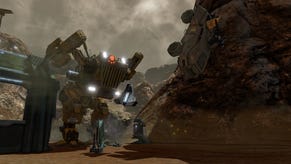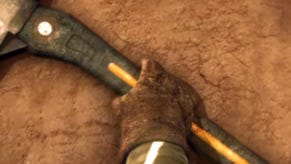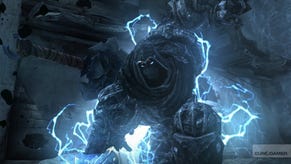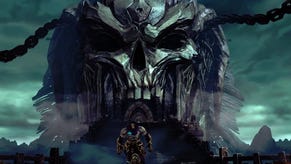Red Faction: Guerrilla
Manic miners.
It's not often, when watching a demo of a dystopian-future third-person action game, amid the constant subwoofer rumble and PR burble of E3, that you wind up in a conversation about the great American architect Frank Lloyd Wright. We're chatting to the art director of THQ's Red Faction: Guerrilla when this unlikely influence is brought up.
However, it's not Wright's clean, proto-modernist designs, nor his massive influence on the course of 20th century architecture, that has led the Volition development team to base buildings on Red Faction's Mars on his work. It's that his fondness for cantilevered construction makes his buildings - theoretically - really easy to knock over. And Red Faction: Guerrilla is all about knocking over.
The game is anchored, as Red Faction always has been, in the latest evolution of Volition's Geo-Mod technology for destructible environments. Geo-Mod is a remarkably realistic physics engine that simulates the stresses of impact and gravity on building materials, rather than just blowing pre-ordained chunks out of them and letting an animation routine take care of the collapse. It's not unlike the incredible Digital Molecular Matter system being used by LucasArts in The Force Unleashed, although Volition seems to be giving the player much freer rein to use it in the latest Red Faction.
The upshot of using Geo-Mod is that buildings - any furniture in the game at all, since it's all destructible - can't just be an art asset, designed to look right. It has to be able to support its own virtual weight. So Volition's artists aren't just studying architects to find out how they can knock things down - they need to find out how they can make them stand up in the first place.
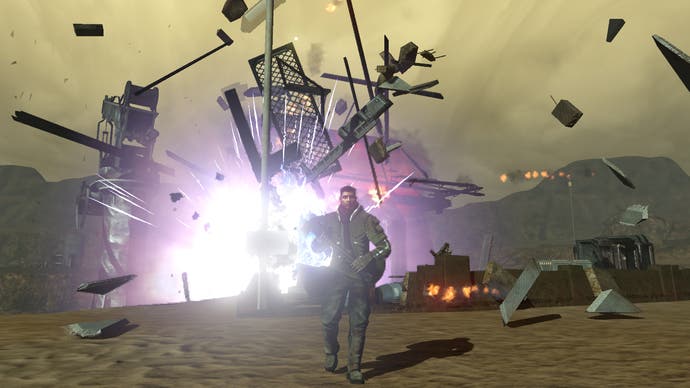
Red Faction: Guerrilla quietly but firmly sweeps Red Faction II under the carpet and returns the action to a terraformed Mars, 50 years after the original game. Once more, you're a freedom-fighting miner - or, at least, aligned with them, since the anonymously grizzled player-character's own background is a mystery. This time, you're struggling out from under the jackboot of the now-tyrannical EDF, or Earth Defence Force (no, not that one), which runs the show on Earth's red neighbour.
The game's shift from first- to third-person, claims Volition, is no marketing twist, but a simple matter of practicality - visibility, to be precise. The destructibility of the environments is so thorough and so complete that death by falling masonry is a constant danger, and it was necessary to put the perspective at one remove to make players aware enough of their surroundings. Compromising on causing damage wasn't an option, since the Guerrilla tactics the game wants you to employ favour dropping bridges on heads, rather than just shooting soldiers in them.
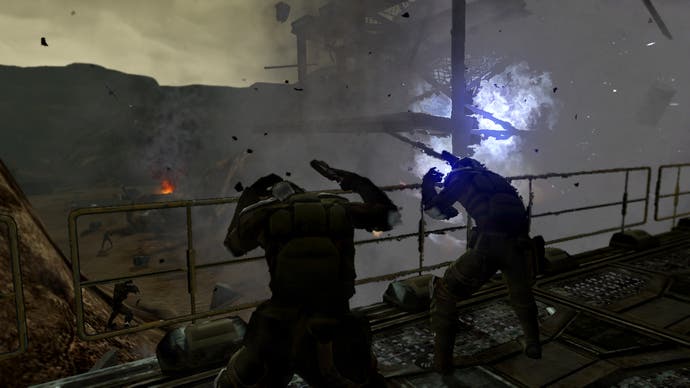
That's the line, anyway. We suspect the third-person perspective also has something to do with the game's structure, which switches Red Faction II's strict corridor shooter out for mission-based gaming in large, open environments with plenty of vehicular action. It's some way shy of free-roaming - there will still be a linear progression through Mars' varied environments, Volition says - but this game is definitely aligning itself with the post-GTA III action template. And, if you can't watch yourself leaping from the driver's seat of a speeding cliché, where's the fun?
We're being a little unfair. In our short demo of the game's single-player, there's little to suggest Red Faction hasn't benefited considerably from its new direction. The grimy, dusty, rusty visuals aren't very arresting, it's true, but they do evoke the Wild West frontier spirit the developer says it's after. So does the action, certainly.


